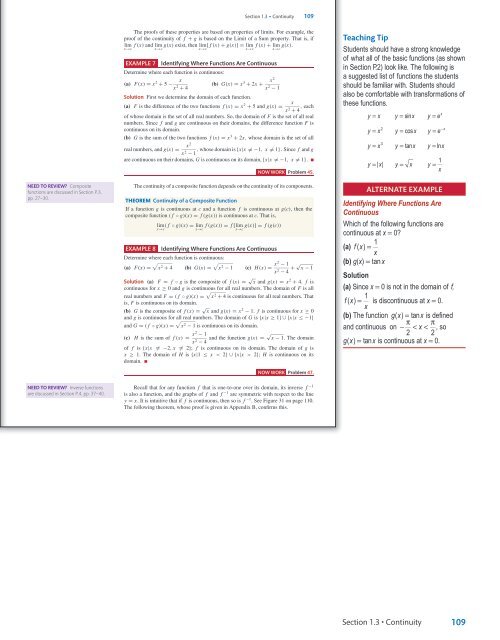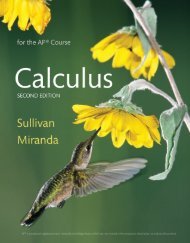Sullivan Microsite TE SAMPLE
Create successful ePaper yourself
Turn your PDF publications into a flip-book with our unique Google optimized e-Paper software.
<strong>Sullivan</strong> AP˙<strong>Sullivan</strong>˙Chapter01 October 8, 2016 17:4<br />
Section 1.3 • Continuity 109<br />
NEED TO REVIEW? Composite<br />
functions are discussed in Section P.3,<br />
pp. 27--30.<br />
The proofs of these properties are based on properties of limits. For example, the<br />
proof of the continuity of f + g is based on the Limit of a Sum property. That is, if<br />
lim f (x) and lim g(x) exist, then lim[ f (x) + g(x)] = lim f (x) + lim g(x).<br />
x→c x→c x→c x→c x→c<br />
EXAMPLE 7<br />
Identifying Where Functions Are Continuous<br />
Determine where each function is continuous:<br />
(a) F(x) = x 2 + 5 −<br />
x<br />
x 2 + 4<br />
(b) G(x) = x 3 + 2x + x 2<br />
x 2 − 1<br />
Solution First we determine the domain of each function.<br />
(a) F is the difference of the two functions f (x) = x 2 + 5 and g(x) =<br />
x<br />
x 2 + 4 , each<br />
of whose domain is the set of all real numbers. So, the domain of F is the set of all real<br />
numbers. Since f and g are continuous on their domains, the difference function F is<br />
continuous on its domain.<br />
(b) G is the sum of the two functions f (x) = x 3 + 2x, whose domain is the set of all<br />
real numbers, and g(x) = x 2<br />
, whose domain is {x|x = −1, x = 1} . Since f and g<br />
x 2 − 1<br />
are continuous on their domains, G is continuous on its domain, {x|x = −1, x = 1} . ■<br />
NOW WORK Problem 45.<br />
The continuity of a composite function depends on the continuity of its components.<br />
THEOREM Continuity of a Composite Function<br />
If a function g is continuous at c and a function f is continuous at g(c), then the<br />
composite function ( f ◦ g)(x) = f (g(x)) is continuous at c. That is,<br />
lim( f ◦ g)(x) = lim<br />
x→c x→c<br />
f (g(x)) = f [lim g(x)] = f (g(c))<br />
x→c<br />
EXAMPLE 8 Identifying Where Functions Are Continuous<br />
Determine where each function is continuous:<br />
(a) F(x) = √ x 2 + 4 (b) G(x) = √ x 2 − 1 (c) H(x) = x 2 − 1<br />
x 2 − 4 + √ x − 1<br />
Solution (a) F = f ◦ g is the composite of f (x) = √ x and g(x) = x 2 + 4. f is<br />
continuous for x ≥ 0 and g is continuous for all real numbers. The domain of F is all<br />
real numbers and F = ( f ◦ g)(x) = √ x 2 + 4 is continuous for all real numbers. That<br />
is, F is continuous on its domain.<br />
(b) G is the composite of f (x) = √ x and g(x) = x 2 − 1. f is continuous for x ≥ 0<br />
and g is continuous for all real numbers. The domain of G is {x|x ≥ 1}∪{x|x ≤−1}<br />
and G = ( f ◦ g)(x) = √ x 2 − 1 is continuous on its domain.<br />
(c) H is the sum of f (x) = x 2 − 1<br />
x 2 − 4 and the function g(x) = √ x − 1. The domain<br />
of f is {x|x = −2, x = 2}; f is continuous on its domain. The domain of g is<br />
x ≥ 1. The domain of H is {x|1 ≤ x < 2} ∪{x|x > 2}; H is continuous on its<br />
domain. ■<br />
NOW WORK Problem 47.<br />
Teaching Tip<br />
Students should have a strong knowledge<br />
of what all of the basic functions (as shown<br />
in Section P.2) look like. The following is<br />
a suggested list of functions the students<br />
should be familiar with. Students should<br />
also be comfortable with transformations of<br />
these functions.<br />
y = x y = sinx y = e<br />
2<br />
y = x y = cos x y = e<br />
−x<br />
3<br />
y = x y = tanx y = lnx<br />
1<br />
y = | x|<br />
y = x y =<br />
x<br />
Alternate Example<br />
Identifying Where Functions Are<br />
Continuous<br />
Which of the following functions are<br />
continuous at x = 0?<br />
1<br />
(a) fx ( ) =<br />
x<br />
(b) g(x) = tan x<br />
Solution<br />
(a) Since x = 0 is not in the domain of f,<br />
1<br />
fx ( ) = is discontinuous at x = 0.<br />
x<br />
(b) The function gx ( ) = tan x is defined<br />
and continuous on − π < x < π , so<br />
2 2<br />
gx ( ) = tanx<br />
is continuous at x = 0.<br />
x<br />
NEED TO REVIEW? Inverse functions<br />
are discussed in Section P.4, pp. 37--40.<br />
Recall that for any function f that is one-to-one over its domain, its inverse f −1<br />
is also a function, and the graphs of f and f −1 are symmetric with respect to the line<br />
y = x. It is intuitive that if f is continuous, then so is f −1 . See Figure 31 on page 110.<br />
The following theorem, whose proof is given in Appendix B, confirms this.<br />
Section 1.3 • Continuity 109<br />
<strong>TE</strong>_<strong>Sullivan</strong>_Chapter01_PART I.indd 6<br />
11/01/17 9:58 am




